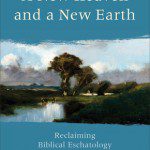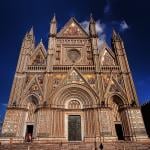 In the third chapter of The Spirit in Creation and New Creation: Science and Theology in Western and Orthodox Realms Jeff Schloss, Professor of Biology at Westmont College in Santa Barbara CA, reflects on the role that Spirit played in creation (past) and plays in creation (present).
In the third chapter of The Spirit in Creation and New Creation: Science and Theology in Western and Orthodox Realms Jeff Schloss, Professor of Biology at Westmont College in Santa Barbara CA, reflects on the role that Spirit played in creation (past) and plays in creation (present).
Hovering Over Waters: Spirit and the Ordering of Creation.
Any discussion of spirit or Spirit in creation needs to start with a definition of spirit. This is not quite as easy as it seems. According to Jeff Schloss “it is not entirely clear what we mean by “spirit.” Theologians differ, and most scientists not only ignore, but actively shun the notion.” (p. 26)
The Latin word spiritus, from which we get the word spirit, the Greek word pneuma, and the Hebrew word rauch all refer to breath. As a consequence Jeff starts with “spirit” as the distinguishing principle of life. Spirit in scripture, however, is more than simply the distinguishing principle of life. The Spirit, capital S as one part of the Trinity, gives life, sustains life, and renews life and this shapes much of Jeff’s chapter.
What do we gain from a spirit-breathed perspective on creation?
Discussion of science and faith, science and the creative spirit of God tends to get bogged down in topics like creation of species, Intelligent Design, the insufficiency of evolutionary mechanisms, the need to demonstrate God. There are, however, more fruitful directions we can take. A spirit-breathed perspective should not attack the natural conclusions of scientific findings, but rather the “purposeless” and “directionless” mantra that is oft repeated in much of the scientific community. In what follows I will summarize what I see as some of Jeff’s most significant points.
Theology provides a starting point. While Jeff sees no reason to eliminate the possibility of “gaps” requiring divine action in the ordering of creation, moving in this direction has scientific and theological risks. It is not a particularly profitable pursuit. Any gap has the potential to be filled by some “natural” explanation. The Spirit is not active only in those places where other explanations fail, but in every aspect of creation. The action of the Spirit in creation is seen not in gaps, but through the life of faith. Theological commitments are the fundamental starting point. He points to the oft cited statement from John Newman, but not original to him “I believe in design because I believe in God; not in God because I see design.”
Far from urging us to inductively posit the presence of the divine from the abridgment of natural regularities, the spirit of Yahweh claims “I will put breath in you and you will come to life. Then you will know that I am the Lord (Ezekiel 37:4). It is the experience of being revived that generates the conviction of God’s presence in the world. The direct experience of being enlivened by God’s breath changes perspective on reality. But of course the task still remains to make sense of the world in light of this perspective. (p. 32)
He refers as well in a footnote to T.S. Eliot’s introduction to Pascal’s Pensees …”the task of the Christian intellectual is not to develop arguments for the virgin birth by calculating the odds of conception by spontaneous parthenogenesis, rather it is to develop a coherent understanding of our beliefs and their relation to the world.” (p. 32)
We have a spirit-breathed perspective on creation that interacts with science in complementary ways. Faith influences plausibility criteria active in science and science also informs belief by affirming and challenging it. Jeff uses the gospel accounts of fishing in Luke 5:4-10 and John 21:4-9, “throw your net on the right side of the boat and you will find some” as examples and a running theme throughout the chapter (hence the picture at the top of the post).
The spirit-breathed perspective can bring insight. A spirit-breathed perspective may take us places in science where the dominant paradigm will not go (easily anyway) … proposals involving directionality, progress, purpose, altruism.
The goal of fishing on the spirit-breathed side of the boat is not to develop an argument, but to seek to engage and understand the world in light of the spirit’s invitation. Whatever the rationale for where the nets are cast, however, it is essential not to tell “fish stories” about the data we pull up, so that the world may push back against and help shape our most fundamental beliefs.” (p. 33)
Scientific inquiry informs belief by both affirming and challenging it. Our faith isn’t separate from the world in which we live, and our experience of the world can affirm faith, as when Peter witnessed the load of fish and fell down at Jesus feet, but it can also generate appropriate doubt.
Not just dust, chemistry and physics. Jeff looks further for engagement with a spirit-breathed perspective in the nature and origin of life and in the history of life. Purpose and directionality figure large here in his reasoning. While it is common in some circles to deny the presence of any purpose or directionality in nature, a spirit-breathed perspective can lead us in a different and perhaps more fruitful direction. Concerning the nature of life Jeff looks at purpose.
… by starting with a precommitment to spirit-breathed character of life (i.e., that while it may be composed of dust, it may not be reducible to the properties of dust), we might cast our nets on the function side of the boat – seeing if biological inquiry that employs the concept yields a catch that we otherwise miss.
This indeed seems to be the case. Biologists find it very difficult to describe, much less explain, living systems without using teleological language. While some have tried to soft-pedal the implications of this by employing notions of teleonomy to avoid the implications of teleology, Robert Brandon and others have argued persuasively that what we see in biology is plain teleology, and we should just use that term. (p. 40)
Teleology: being directed toward an end or shaped by a purpose; teleonomy: the quality of apparent purposefulness. The current paradigm rules out teleology, perhaps here a spirit-breathed perspective leads us toward truth.
The history of life has direction. Consideration of the history of life can gain perspective from a spirit-breathed approach to biology.
One of the long-standing and common understandings of “spirit” is that it is the very breath of creativity, that which inspires art itself. If nature is the art of God, what are its themes? … The debate over the relationship of these questions of telos to evolutionary change has been even more significant than the question of telos to organic function. But if there is a God who not only created the stage for the historical drama, but in some sense both directs the play and has joined the cast, there must be a discernible (though by no means unambiguous) plot. (p. 42)
 Jeff looks at the trajectory in the history of life and doesn’t see a random, purposeless creation. Evolutionary mechanism can be “purposeless” and still serve a purpose. The roll of dice in Monte Carlo is purposeless, yet serves a purpose. There is progress and directionality in the history of life. The major evolutionary transitions cross thresholds involving “obligate interdependence” and once the threshold is crossed “the nature of the interdependence then progressively intensifies.” The major thresholds are things like single cell, no nucleus -> single cell with nucleus -> multicellular -> social organisms. There is an expansion of “biotic potency,” the realm of biological possibility and of integration into larger units represent directionality.
Jeff looks at the trajectory in the history of life and doesn’t see a random, purposeless creation. Evolutionary mechanism can be “purposeless” and still serve a purpose. The roll of dice in Monte Carlo is purposeless, yet serves a purpose. There is progress and directionality in the history of life. The major evolutionary transitions cross thresholds involving “obligate interdependence” and once the threshold is crossed “the nature of the interdependence then progressively intensifies.” The major thresholds are things like single cell, no nucleus -> single cell with nucleus -> multicellular -> social organisms. There is an expansion of “biotic potency,” the realm of biological possibility and of integration into larger units represent directionality.
[These themes] are concordant with the notion of God’s immanence: the Spirit breathes life into creation, sustains and renews the breath and flourishing of all creatures; the Word sequentially brings order out of chaos. And both represent surprise catches on the side of the boat underfished by the nets cast according to the prevailing wind of scientific fashion, if not theoretical entailment. (pp. 46-47)
For Christians science and theology belong together. Jeff concludes by emphasizing once again that he is not describing demonstrations of the necessary presence of the spirit for an unbelieving world, but the ways in which a spirit-breathed perspective can make sense of the world in which we live.
It would be wrong to suggest that these themes of evolutionary history and the causal structures underlying them constitute demonstrations of the Spirit’s role in creation … But it would be equally wrong to reject as incommensurate with or dismiss as irrelevant to theology the themes of the causal structure of life’s history. These notions of the progressive intensification of life, of fecundity [i.e. reproductive capacity]and constraint, of generative and filtering interplay are concordant with ancient insights into the meaning and operation of the Spirit in animating and ordering, in nourishing and pruning, in expanding the possible and bringing the actual to pass. (p. 48-49)
When we fight about gaps, intelligent design, and evolution we miss the most important points. A spirit-breathed perspective is consistent with the science, it can lead science into profitable directions (toward teleology perhaps), and is in agreement with the ways in which we see the action of the spirit in scripture.
What do you think?
Does a spirit-breathed perspective as described by Jeff bring something important into the discussion?
If you wish to contact me directly you may do so at rjs4mail[at]att.net
If interested you can subscribe to a full text feed of my posts at Musings on Science and Theology.











